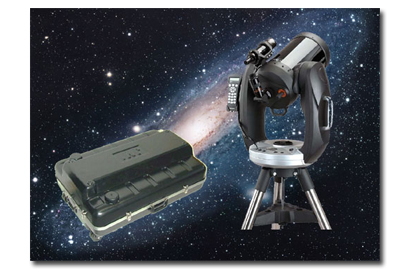|
|
 |
Knowledge Is Key
For Intelligent Decisions
Satellite Logic is a leading,
authoritative source of information in
the Satellite Industry. Located in the
heart of the Silicon Valley, Satellite
Logic provides one of the most
valuable and comprehensive
knowledge bases on the Satellite
market! This is a primary Worldwide
information center which enables our
clients to analyze, evaluate, inquire
and select their best tailored
solutions. Our company sets the
industry standards for targeted
buying leads, reflecting a dramatic
advance over traditional marketing
solutions.
|
|
|
 |

GPS telescopes are a very interesting technological innovation. In
fact, novice users and advanced amateur astronomers are enjoying
two fascinating worlds - the amazing world of the GPS technology
and incredible world of astronomy.
Before diving into the skies with their GPS telescope, astronomers
have now a much easier job. Today, once they open the new
telescopes, they can find out exactly where they are and receive
precious information related to the things they see. Before the GPS
telescopes, they had to do a lot of paper work, but not anymore.
The new generations of GPS telescopes combine precise motor
controls, position sensors, GPS receivers, and excellent optics into
one single advanced telescopic unit. The "go-to" telescopes enable
the users to view the moon, the planets, nebulas, galaxies, star
clusters, and other celestial objects by simply pressing a few
buttons. And as if it is not enough, by connecting the GPS telescope
to a computer, its functionality and ease of use can be even further
extended.
The GPS telescope's communications interface can instruct the
telescope to slew or "go to" specified coordinates, to query the
telescope's current position, and obtain other information such as
slewing status, the GPS date and time, and the user's geographic
coordinate. Since the GPS telescope knows exactly its position, all
it needs to be pointed to certain planets are a few basic calculations.
Basically, it's like knowing your exact position and driving to a certain
destination. Only that with a telescope you don't actually drive to
the destination, you only watch it.

The GPS telescope open new horizons for taking pictures with a
digital camera. Low light video and digital cameras can utilize the
telescope's interface to produce fresh new applications. An
automated guider can permit long time exposures with a digital
camera. Long time exposures (2 minutes or more) require extremely
precise tracking to produce excellent astrophotographs. A low light
video camera and the Java JMF can be used to capture "guide" stars.
The position of the guide stars will be compared from frame to frame
to correct drift caused by telescope drive irregularities and alignment.
Augmented displays can combine graphic overlays with video output
and assist the amateur telescope user in various tasks.
Once you turn a GPS telescope on, its sensor will immediately
determine your precise date, time and location. This information will
help the telescope to get aligned for a tour of the most spectacular
sights in the universe. Telescopes that are pre-aligned are smart
scopes that know the night sky right out of the box. AutoAlign picks
two fail-proof alignment stars for you and places them right in your
viewfinder. Just center them to fine tune your alignment and the
wonders of the universe are at your fingertips. You'll see planets,
stars, galaxies, nebulae and comets - all at the push of a button.
And if you don't know the night sky yet, the telescope will do it for
you. It will automatically point you to the best objects in the sky.
Astronomy has never been so easy and rewarding as it is now. And
not only these telescopes get better all the time, they can be
updated after purchase on a regular base. In other words, sky
is the limit.
|
|
|
|
